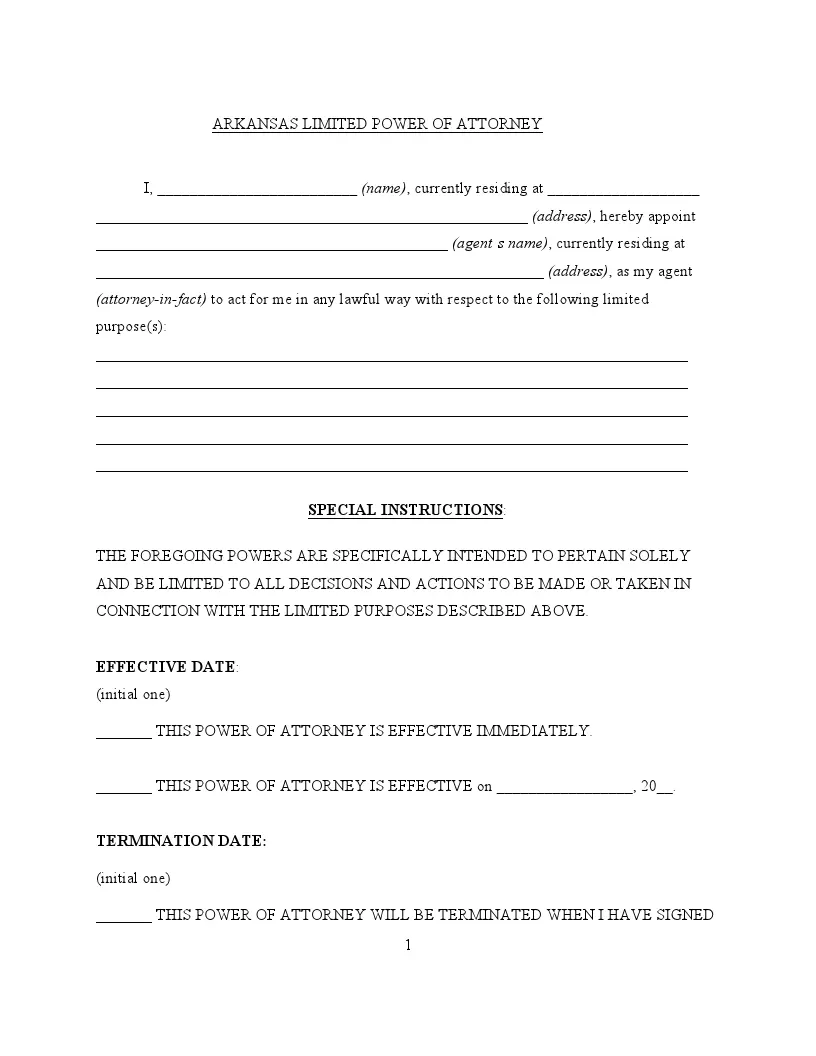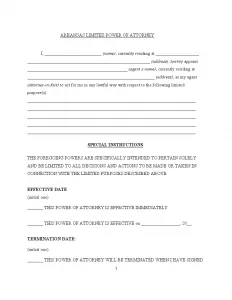Arkansas Limited Power of Attorney Form
The Arkansas limited power of attorney is a legal document that grants specific powers to an agent to act on your behalf under certain circumstances. This form can be tailored to meet specific needs, such as handling financial matters, real estate transactions, or other specified duties for a limited period or under certain conditions.
The principal grants the authority, and the agent or attorney-in-fact receives it. The scope and duration of the powers are clearly defined in the document creating the power of attorney. For example, the principal might grant an agent the power to sell a property but limit that authority to three months.
On FormsPal, you can easily access and complete Arkansas power of attorney forms to designate someone to act on your behalf for specific tasks.

Build Your Document
Answer a few simple questions to make your document in minutes
Save and Print
Save progress and finish on any device, download and print anytime
Sign and Use
Your valid, lawyer-approved document is ready
The Uniform Power of Attorney Act governs the signing requirements and regulations for a limited POA, detailed within Sections 28-68-101 to 28-68-406 of the Arkansas Code. This legal framework specifies how a power of attorney should be executed to grant an agent the authority to act on the principal’s behalf. Requirements for the execution of a power of attorney in Arkansas include:
- Signature of the Principal. The individual granting power must sign the document.
- Notarization. The principal’s signature must be notarized. This step verifies the principal’s identity and confirms that the signature is genuine.
Section 28-68-201 clarifies that an agent may only act within the limits of the authority expressly granted by the power of attorney document. This means that the powers delegated to the agent are not assumed to be broad or general unless specified directly in the document. Further, the principal retains the right to revoke the power of attorney at any time as long as they possess the mental capacity to make such decisions, as detailed in Section 28-68-110.
Arkansas Limited Power of Attorney Form Details
| Document Name | Arkansas Limited Power of Attorney Form |
| Other Name | Arkansas Special Power of Attorney |
| Relevant Laws | Arkansas Code, Section 28-68-201 |
| Avg. Time to Fill Out | 8 minutes |
| # of Fillable Fields | 32 |
| Available Formats | Adobe PDF |
Filling Out Arkansas Limited POA
This step-by-step guide will walk you through filling out the Arkansas limited power of attorney form, ensuring it meets legal standards and accurately reflects your intentions.
1. Enter the Principal’s Information
Please enter your full name and current residential address in the designated spaces at the beginning of the form. This will identify you as the principal, the person granting the power of attorney.
2. Designate Your Agent
Fill in the following fields:
- Agent’s Name. Write the full name of the person you are appointing as your agent.
- Agent’s Address. Provide your agent’s current residential address.
This person will have the authority to act on your behalf in the matters specified in the form.
3. Define the Powers Granted
Specify the exact powers you are granting to your agent. Detail the tasks your agent is authorized to perform on your behalf. Use clear, concise language to avoid ambiguity about the authority’s scope.
4. Set the Effective Date
Indicate when the power of attorney will go into effect. You can choose if it will be effective immediately or start later. Initial the option that applies to your choice.
5. Determine the Termination Date
Decide when the power of attorney will end. Options typically include:
- End by a specific date. Enter the termination date if you want the power to expire on a particular day.
- Revocation. Indicate that the power will end if you sign a written revocation.
- Incapacity. State that the power will terminate if you are determined to be incapacitated.
Initial next to the condition that applies.
6. Appoint a Successor Agent
If you wish, appoint a successor agent who will take over if the primary agent is unable to serve. Provide the name and address of the successor agent.
7. Sign and Date the Form
Sign the form in the presence of a notary public on the specified day and month. Ensure the notary fills out the acknowledgment section, verifying your identity and the authenticity of your signature.
8. Notarization
The notary public will sign and seal the document, completing the legal formalities necessary for the power of attorney to be recognized and enforceable in Arkansas.
Ensure all information is correct and the form fully reflects your wishes regarding the limited power of attorney. Once completed, provide a copy to your agent and possibly a third party if they will interact with the agent under this authority. Keep the original document in a safe place.
